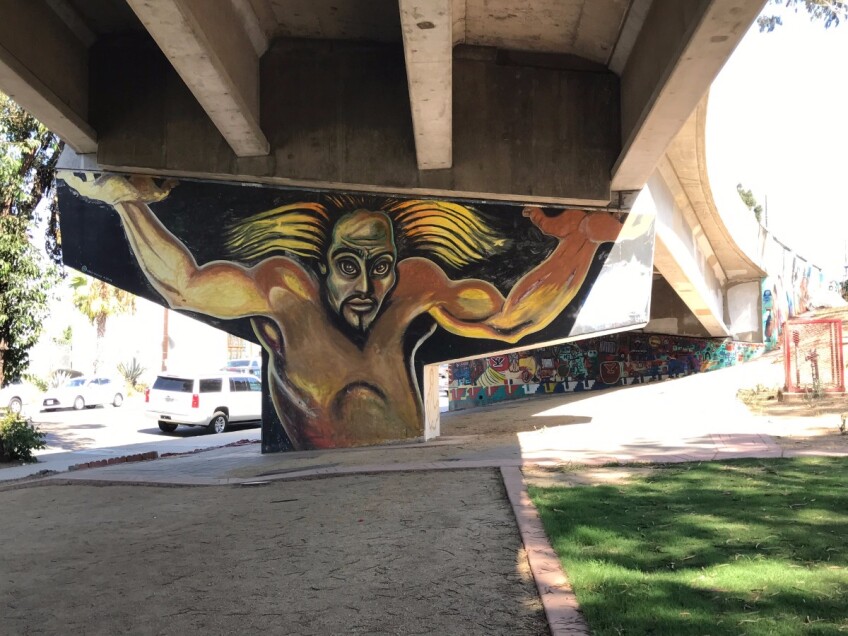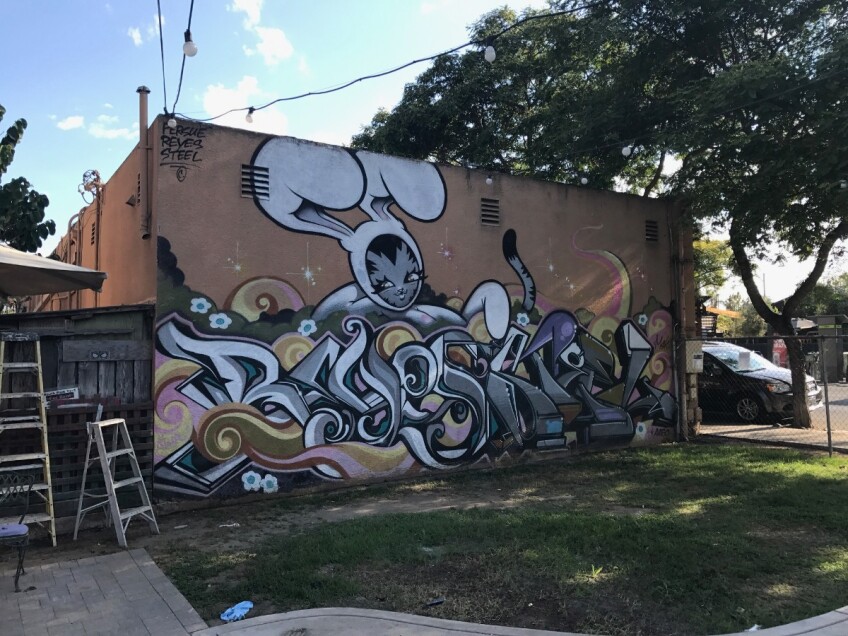A Wave of Street Art for San Diego

The city of San Diego is known for its amazing weather, pristine beaches and holding the distinction as America’s Finest City. It’s also home to numerous art institutions in Balboa Park and dozens more that are spread across the county. However, there is another important genre of visual art that complements and sometimes challenges how we engage the visual landscape of the city outside the walls of its galleries and museums. Sometimes it’s hidden, and in other cases, it’s featured, but it varies dramatically based on the many neighborhoods of San Diego and hosts a number of important champions.
The genre of street art was born out of graffiti (letter-based images instead of picture based) in the 1970s and has become a stimulus for urban art growth. City’s like San Diego facilitate graffiti, street art and murals (legal graffiti and street art) because it promotes an atmosphere that many businesses and developers admire. This is a far cry from the broken window theory that cities maintained in the past to discourage larger crimes. From illegal work to carefully curated pieces, San Diego has become a significant destination to see work by local artists and visitors from around the world. From downtown to North County, locals alongside invited guests have worked to establish a culture of street art that has many purposes and objectives that go far beyond just pleasing aesthetics.

Significant individuals like Jason Gould, owner of the hybrid gallery and art supply store visual has long been promoting exhibitions and opportunities for local artists. Gould founded the Visual Public Art Project and has facilitated over 180 painted electrical boxes in the city. These once drab boxes have now become colorful canvases that provoke viewers to rethink the purpose of such utilitarian design. In a similar vein, Writerz Blok was founded in 1999 by the Jacobs Center for Neighborhood Innovation.It offers artists an outlet for doing graffiti legally. This program grew from being nomadic to establishing themselves on private property in San Diego. Anyone is welcome and it’s another sign of a local organization making opportunities for public expression possible. Additional areas for graffiti and street art have also seen the establishment of the MAAC Center, a giant lot surrounded by walls where a large graffiti event is held once a year and Makers Quarter, a destination that allowed a few artists to paint mural-sized works with maximum exposure in a well-traversed section of the city.

Plus there are organizations outside the city, like the PangeaSeed Foundation that collaborate with internationally-acclaimed artists to bring large-scale works to the streets of San Diego to raise awareness for environmental change in our oceans. They call it ARTivism and through murals or Seawalls, they bring this message of ocean conservation to the street. In a city like San Diego, such messages resonate incredibly well and are a welcome addition to any neighborhood.
Downtown San Diego, which earned the nickname the Toolbox because of the various shapes of the building that makes up the skyline, is quite different from larger cities like Los Angeles because there are very few alleyways. These crevices often are great locations for smaller artworks. However, despite the plethora of modern buildings downtown, there are a number of impressive works like the Os Gemeos mural called “Don’t Believe the Hype” which was part of the Museum of Contemporary Art, San Diego’s 2010 exhibition “Viva La Revolución” that extended into the city. In fact, the exhibit curated by Pedro Alonzo still has several murals that remain around the city including the largest Invader in North America, evidence that San Diego businesses are willing to partner with arts organizations.
Downtown San Diego is also home to Tribal Streetwear, a company that was founded by Bobby and Joey Ruiz and in 1989. Together they created a platform for graffiti artists to design clothing. Distributing their products worldwide, they have been an important supporter of the arts by employing and spotlighting talented artists — many of whom have gone on to found their own companies.
Of all the locations for street art, locals will always mention Chicano Park and the significant place it holds in the city’s history. Located under the Coronado Bridge in Barrio Logan, it hosts a large number of murals celebrating the culture heritage of the surrounding community that is largely immigrants from Mexico and Mexican Americans. The location was divided in two when the freeway was built in 1963 and again in 1969 when the Coronado Bridge onramps were placed right in the middle of the park. The establishment of the park only happened because of a militant nonviolent takeover by the community. Journalist Ed Fuentes understands that “The site is a major part of the story; it adds a literary device of tension by being a symbol of eradication by severing a community, and it gives dramatic context to the way murals reclaimed space. And the name Chicano Park still trumpets as a declaration of a time when murals began to voice neighborhoods.” Chicano Park continues to be painted, celebrated, and cared for by the community. In 2013 it was finally registered as a National Historic Landmark and has the protection it deserves. The murals themselves travel up and down the support systems of the bridge and are a colorful and creative mark on the city.


The affluent city of La Jolla just north of San Diego is home to the Museum of Contemporary Art and The Athenaeum Music & Arts Library. The latter along with the La Jolla Foundation has been instrumental in facilitating murals by a number of contemporary artists over the years including John Baldessari, Mel Bochner, Ann Hamilton and William Wegman. The professional aspect of these walls is not lost in being outside, tours are available, making them an extension of the art that resides inside many of La Jolla’s museums and galleries yet they also retain an institutional feel through their execution.
The bustling neighborhood of North Park is an area reminiscent of Los Angles. Here you will find a mixture of trendy independent shops alongside bigger chain stores. The back alleys and spread out geography differentiates from downtown making a friendlier environment for murals, street art and graffiti. Mike from @Sandiegostreetartdocument, a long time photographer, explains that: “Diversity is the defining aspect when it comes to public art found in San Diego … every neighborhood in San Diego definitely has its own personality and the art in those areas are usually very representative of that area. In places like Barrio Logan and Logan Heights, a lot of the art and graffiti reflects the strong Hispanic and cultural pride…near downtown and the east village you find more illustrative and contemporary work, reflecting a fast-paced progressive feel of a busy city. Artist Gloria Muriel echoes these sentiments: “San Diego is opening more to street art than ever… Every wall is a different experience depending on where you are; there's a different neighborhood with a special community and a unique history behind it.”
The beach communities of North County are also sprinkled with wall art up and down Highway 101. Bryan Snyder, a Carlsbad based street artist notices that “Beach communities up and down the coast are seeing the benefits of colorful walls…A difference between San Diego proper and North County San Diego has been the subject matter. Downtown urban environments tend to be a bit more progressive aesthetically.” While this appears to be true, there definitely appears to be a taste for street art in the coastal communities, where many of the most recent public art can be found.
The subculture of graffiti and street art that has grown on the sides of blank walls differs in San Diego because of its size and due to some of the city’s unique characteristics. Yet it’s very much is part of the fabric of San Diego and the city is fortunate to have so many advocates and practitioners. From the staunch Liberty Station mural in Point Loma welcoming guests to the expressive graffiti of Persue, Reyes, and Steel in South Park, San Diego’s public art scene is exciting, vibrant, and certainly on the rise.

Top Image: Sake mural | G. James Daichendt
Looking for a more immersive experience? Follow along with Dr. Jim Daichendt on his self-guided audio tour of the best street art in San Diego.






